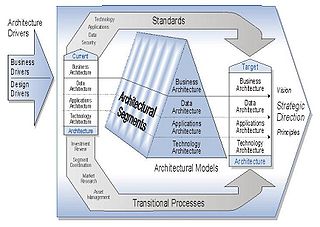Difference between revisions of "Federal Enterprise Architecture Framework (FEA)"
m (The LinkTitles extension automatically added links to existing pages (https://github.com/bovender/LinkTitles).) |
m |
||
| (2 intermediate revisions by the same user not shown) | |||
| Line 1: | Line 1: | ||
| − | '''A Federal Enterprise | + | == What is the Federal Enterprise Architecture Framework (FEA)? == |
| + | |||
| + | '''A Federal Enterprise Architecture (FEA)''' is the [[Enterprise Architecture]] of the federal government. It provides a common approach for the integration of strategic, business and technology management as part of organization design and performance improvement.<ref>Definition of FEA Framework [https://en.wikipedia.org/wiki/Federal_enterprise_architecture Wikipedia]</ref> | ||
| Line 7: | Line 9: | ||
*Strategic Direction | *Strategic Direction | ||
*Current Architecture | *Current Architecture | ||
| − | * | + | *Target Architecture |
*Transitional Processes | *Transitional Processes | ||
*Architectural Segments | *Architectural Segments | ||
*Architectural Models | *Architectural Models | ||
*Standards | *Standards | ||
| − | The FEAF also provides direction for establishing "Federal segments", which are cross-agency business areas (such as international trade, grants, common patient records) that transcend federal agency boundaries. These federal architectural segments collectively constitute the Federal | + | The FEAF also provides direction for establishing "Federal segments", which are cross-agency business areas (such as international trade, grants, common patient records) that transcend federal agency boundaries. These federal architectural segments collectively constitute the Federal Enterprise Architecture. |
| − | The FEAF partitions a given architecture into business, | + | The FEAF partitions a given architecture into business, data, applications, and technology architectures, as shown in the following figure. The FEAF currently includes the first three columns of the [[Zachman Framework]] and the Spewak Enterprise Architecture Planning (EAP) methodology. |
| Line 21: | Line 23: | ||
'''FEA Framework v2'''<ref>The FEA Framework v2 [https://www.whitehouse.gov/sites/default/files/omb/assets/egov_docs/fea_v2.pdf whitehouse.gov]</ref><br /> | '''FEA Framework v2'''<ref>The FEA Framework v2 [https://www.whitehouse.gov/sites/default/files/omb/assets/egov_docs/fea_v2.pdf whitehouse.gov]</ref><br /> | ||
| − | The Federal | + | The Federal Enterprise Architecture Framework v2 describes a suite of tools to help government planners implement the Common Approach. At its core is the [[Consolidated Reference Model (CRM)]], which equips OMB and Federal agencies with a common language and framework to describe and analyze investments. It consists of a set of interrelated “reference models” that describe the six sub-architecture domains in the framework: |
| − | * | + | *Strategy |
*Business | *Business | ||
*Data | *Data | ||
| Line 28: | Line 30: | ||
*Infrastructure | *Infrastructure | ||
*Security | *Security | ||
| − | These are designed to facilitate cross-agency analysis and the identification of duplicative investments, gaps and opportunities for | + | These are designed to facilitate cross-agency analysis and the identification of duplicative investments, gaps and opportunities for collaboration within and across agencies. Also, by applying all six reference models, agencies can establish a line of sight from the strategic goals at the highest organizational level to the software and hardware infrastructure that enable the achievement of those goals. Collectively, the reference models comprise a framework for describing important elements of federal agency operations in a common and consistent way. |
===See Also=== | ===See Also=== | ||
| − | [[ | + | *[[Enterprise Architecture Framework]] |
| − | |||
| − | |||
| − | |||
| − | |||
| − | |||
| − | |||
| − | |||
| − | |||
| − | |||
| − | |||
Revision as of 10:55, 16 July 2023
What is the Federal Enterprise Architecture Framework (FEA)?
A Federal Enterprise Architecture (FEA) is the Enterprise Architecture of the federal government. It provides a common approach for the integration of strategic, business and technology management as part of organization design and performance improvement.[1]
FEA Framework v 1.1[2]
The FEAF describes eight components of an enterprise architecture:
- Architecture Drivers
- Strategic Direction
- Current Architecture
- Target Architecture
- Transitional Processes
- Architectural Segments
- Architectural Models
- Standards
The FEAF also provides direction for establishing "Federal segments", which are cross-agency business areas (such as international trade, grants, common patient records) that transcend federal agency boundaries. These federal architectural segments collectively constitute the Federal Enterprise Architecture. The FEAF partitions a given architecture into business, data, applications, and technology architectures, as shown in the following figure. The FEAF currently includes the first three columns of the Zachman Framework and the Spewak Enterprise Architecture Planning (EAP) methodology.

source: CIO Council
FEA Framework v2[3]
The Federal Enterprise Architecture Framework v2 describes a suite of tools to help government planners implement the Common Approach. At its core is the Consolidated Reference Model (CRM), which equips OMB and Federal agencies with a common language and framework to describe and analyze investments. It consists of a set of interrelated “reference models” that describe the six sub-architecture domains in the framework:
- Strategy
- Business
- Data
- Applications
- Infrastructure
- Security
These are designed to facilitate cross-agency analysis and the identification of duplicative investments, gaps and opportunities for collaboration within and across agencies. Also, by applying all six reference models, agencies can establish a line of sight from the strategic goals at the highest organizational level to the software and hardware infrastructure that enable the achievement of those goals. Collectively, the reference models comprise a framework for describing important elements of federal agency operations in a common and consistent way.
See Also
References
Further Reading
- Basics of the Federal Enterprise Architecture Framework Innovategov.org
- How to survive in the jungle of Enterprise Architecture Frameworks - Federal Enterprise Architecture Framework (FEAF)© PSU.edu
